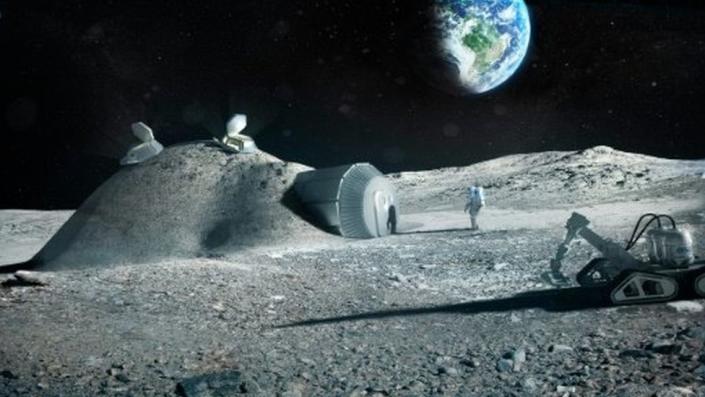Science
Can humanity’s new giant leap into space succeed?
|
|
There is a new order emerging in space – a race between America and China. But with the demands of space exploration, even these great superpowers won’t be able to do it alone.
Hugely technically challenging and costly goals have been touted, not least the aim of people living and working on other worlds, possibly within ten years – but in a divided world where international good will is scarce, are they realistic?
Nasa’s return to the Moon has begun with its Artemis programme. The first of three missions has been successfully launched. This uncrewed flight tested that the rockets and technology worked. The second mission will take humans further in space than they have ever gone before and the third launch will put astronauts on the Moon for a week, where they will carry out experiments. The long-term goal is to use the Moon as a jumping off point to get to Mars.
But the programme is estimated to cost $93bn (£76bn), a heavy price tag for the American taxpayer, who is already feeling the economic squeeze.
In a report to Congress last year, the US Auditor General’s office warned of an “unrealistic development schedule” and likely overruns, adding that Nasa needed to make cost estimates “more reliable and transparent”.
Yet although Nasa will get less overall funding than it asked for in 2023, Congress, at the moment, still supports its human space exploration ventures.
China has achieved its own fully operational space station, Tiangong, in orbit on schedule. The Chinese space programme has launched probes to the Moon and Mars. It plans to establish an unmanned research station on the Moon by 2025 and then land astronauts on its surface by 2030.
Pallab Ghosh and Kate Stephens look at the rapid expansion in space exploration which will lead to people living and working on other worlds.
Putting an astronaut on the Moon has been done before but the next step, to Mars, is much more difficult. It is 250 times further away than the Moon and there is no spacecraft currently capable of sending humans to the red planet.
Even if scientists can find a safe way to launch a fuel-heavy rocket and land it on a planet with such a thin atmosphere, there is the further challenge of returning the astronauts safely home after months in space.


Historically superpowers have jostled for supremacy above the Earth. America and Russia vied for dominance in the 1950s and 1960s. The Russians put the first man in orbit. The Americans landed a man and planted their flag on the Moon a few years later.
In the 1970s a golden era of cooperation was forged culminating in the construction of the International Space Station (ISS), which began in 1998.
Along with 13 other partner nations, the two superpowers built what is now the largest structure in space. It is not owned by any one nation, and each depends on the other to operate.


It was a symbol of what humanity could achieve if nations put aside their differences and worked together.
But the reality was somewhat different. Notably America prevented China from becoming a partner in the ISS, so the Chinese went their own way.
More recently, within weeks of the invasion of Ukraine, nations stopped working with Russia. Two joint Moon missions between the European Space Agency (ESA) and Russia have been cancelled, as has a joint Mars Rover project to search for signs of life on the red planet.


Yet scratch the surface and collaboration continues on the ISS, where Western countries have to work with Russia to maintain it in orbit. Americans and Europeans even still train in the centre of Moscow at Russia’s Space HQ, Star City.
But what happens once the ISS comes to the end of its lifetime in 2030?
Juliana Suess, a space policy analyst at the Royal United Services Institute think tank in London says Russia has much less to offer partner nations than it once did because its technology is outdated. She raises the possibility that the first nation into space could be the first one out.
“If the Russians haven’t figured out an alternative by the time the ISS is decommissioned or develops its own space station, which given the current circumstances and sanctions is quite unlikely, it might not have any human spaceflight,” she says.
Russia’s plight comes at a time when China’s space programme is advancing rapidly. In the last ten years it has launched more than 200 rockets, even though America’s spending on space still makes China’s look small.
China is mindful that partnerships offer technical know-how and money. It has invited other nations prohibited from access to the ISS to join them and has made a call for proposals for scientific experiments.


Seventy-two countries now have their own space programmes because they can’t afford to be left behind in what has become a new space race.
The billionaire spacefarers
Space is a vital part of our everyday lives. We depend on satellites for weather forecasts, communications, bank transitions, not to mention valuable surveillance tools for nation states. And it’s getting busy out there. In 2021 about 5,000 satellites were launched. Going back 20 years, about 800 were launched annually.
Space is an expensive and technically difficult business. No one country can do it alone. New partnerships are being forged, notably with the new brash billionaires on the block.
Elon Musk’s company, SpaceX, is already taking passengers into orbit. The billionaire entrepreneur is bringing down costs with a reusable rocket. Not to be outdone, Amazon’s Jeff Bezos wants to build a commercial orbiting station, called Orbital Reef.
Helen Sharman, who was the UK’s first astronaut, on a mission to the Soviet Space Station Mir in 1991, believes that current international rivalries could be put in the shade by the pragmatism of the private sector.
“It really is going to be commercialisation that brings companies together worldwide,” she told the BBC. “We don’t care where they are registered, what matters is what they do for the benefit of the world.”
The prospect of financial gain and scientific discovery drives collaboration. Private companies may help to bring a new cooperation in space but they have to obey the laws of their home country. When nations imposed sanctions on Russia in 2022 firms were obliged to withdraw from contracts with Russia.
Dr Josef Aschbacher, who is head of the European Space Agency, is determined to keep Europe in the new space race. He has recently had a £2bn ($2.4bn) increase in funding, despite the financial squeeze facing governments.
“Space is one of those sectors which is expanding very fast and much faster now than in the last few decades. We cannot lose out,” he told the BBC. “We really need to participate strongly in this sector because I want to create new business opportunities for companies in our member states to participate in.”


It will be nations that lead space exploration of the future. But the challenges will require them coming together as a single group or “bloc” of countries to share information and to compete with other blocs. The European Space Agency has been doing this successfully for years.
New laws for space
But what is potentially going to hold back the next big push to other worlds is the set of international laws governing space. The marvellously named “Outer Space Treaty” has not been updated since it was signed in 1967, when 31 nations, including the US and the Soviet Union, pledged not to have nuclear weapons in space.
According to Juliana Suess of the Royal United Services Institute, it is not fit for purpose.
“It doesn’t talk about companies; it doesn’t talk about billionaires,” she said. “Space is entirely different to what it was like in 1967.”


New rules to regulate the commercial exploitation of the Moon, Mars and beyond were introduced by the UN in 1979 but the US, China and Russia have all refused to sign it.
ESA’s Josef Aschbacher believes the new space race will be hampered until a new outer space treaty is hammered out.
“In space we are using the same orbits for satellites, using the same Moon surface for China, the US, Europe,” he said. “We need a way to work together to establish rules of engagement and establish rules of how we work there.”





Science
SpaceX launch marks 300th successful booster landing – Phys.org


SpaceX sent up the 30th launch from the Space Coast for the year on the evening of April 23, a mission that also featured the company’s 300th successful booster recovery.
A Falcon 9 rocket carrying 23 of SpaceX’s Starlink internet satellites blasted off at 6:17 p.m. Eastern time from Cape Canaveral Space Force Station’s Space Launch Complex 40.
The first-stage booster set a milestone of the 300th time a Falcon 9 or Falcon Heavy booster made a successful recovery landing, and the 270th time SpaceX has reflown a booster.
This particular booster made its ninth trip to space, a resume that includes one human spaceflight, Crew-6. It made its latest recovery landing downrange on the droneship Just Read the Instructions in the Atlantic Ocean.
The company’s first successful booster recovery came in December 2015, and it has not had a failed booster landing since February 2021.
The current record holder for flights flew 11 days ago making its 20th trip off the launch pad.
SpaceX has been responsible for all but two of the launches this year from either Kennedy Space Center or Cape Canaveral with United Launch Alliance having launched the other two.
SpaceX could knock out more launches before the end of the month, putting the Space Coast on pace to hit more than 90 by the end of the year, but the rate of launches by SpaceX is also set to pick up for the remainder of the year with some turnaround times at the Cape’s SLC-40 coming in less than three days.
That could amp up frequency so the Space Coast could surpass 100 launches before the end of the year, with the majority coming from SpaceX. It hosted 72 launches in 2023.
More launches from ULA are on tap as well, though, including the May 6 launch atop an Atlas V rocket of the Boeing CST-100 Starliner with a pair of NASA astronauts to the International Space Station.
ULA is also preparing for the second launch ever of its new Vulcan Centaur rocket, which recently received its second Blue Origin BE-4 engine and is just waiting on the payload, Sierra Space’s Dream Chaser spacecraft, to make its way to the Space Coast.
Blue Origin has its own rocket it wants to launch this year as well, with New Glenn making its debut as early as September, according to SLD 45’s range manifest.
2024 Orlando Sentinel. Distributed by Tribune Content Agency, LLC.
Citation:
SpaceX launch marks 300th successful booster landing (2024, April 24)
retrieved 24 April 2024
from https://phys.org/news/2024-04-spacex-300th-successful-booster.html
This document is subject to copyright. Apart from any fair dealing for the purpose of private study or research, no
part may be reproduced without the written permission. The content is provided for information purposes only.
Science
Wildlife Wednesday: loons are suffering as water clarity diminishes – Canadian Geographic


The common loon, that icon of northern wilderness, is under threat from climate change due to declining water clarity. Published earlier this month in the journal Ecology, a study conducted by biologists from Chapman University and Rensselaer Polytechnic Institute in the U.S. has demonstrated the first clear evidence of an effect of climate change on this species whose distinct call is so tied to the soundscape of Canada’s lakes and wetlands.
Through the course of their research, the scientists found that July rainfall results in reduced July water clarify in loon territories in Northern Wisconsin. In turn, this makes it difficult for adult loons to find and capture their prey — mainly small fish — underwater, meaning they are unable to meet their chicks’ metabolic needs. Undernourished, the chicks face higher mortality rates. The consistent foraging techniques used by loons across their range means this impact is likely echoed wherever they are found — from Alaska to Canada to Iceland.
The researchers used Landsat imagery to find that there has been a 25-year consistent decline in water clarity, and during this period, body weights of adult loon and chicks alike have also declined. With July being the month of most rapid growth in young loons, the study also pinpointed water clarity in July as being the greatest predictor of loon body weight.
One explanation for why heavier rainfall leads to reduced water clarity is the rain might carry dissolved organic matter into lakes from adjacent streams and shoreline areas. Lawn fertilizers, pet waste and septic system leaks may also be to blame.
The researchers, led by Chapman University professor Walter Piper, hope to use these insights to further conservation efforts for this bird Piper describes as both “so beloved and so poorly understood.”
Return of the king
Science
Giant prehistoric salmon had tusk-like teeth for defence, building nests


|
|
The artwork and publicity materials showcasing a giant salmon that lived five million years ago were ready to go to promote a new exhibit, when the discovery of two fossilized skulls immediately changed what researchers knew about the fish.
Initial fossil discoveries of the 2.7-metre-long salmon in Oregon in the 1970s were incomplete and had led researchers to mistakenly suggest the fish had fang-like teeth.
It was dubbed the “sabre-toothed salmon” and became a kind of mascot for the Museum of Natural and Cultural History at the University of Oregon, says researcher Edward Davis.
But then came discovery of two skulls in 2014.
Davis, a member of the team that found the skulls, says it wasn’t until they got back to the lab that he realized the significance of the discovery that has led to the renaming of the fish in a new, peer-reviewed study.
“There were these two skulls staring at me with sideways teeth,” says Davis, an associate professor in the department of earth sciences at the university.
In that position, the tusk-like teeth could not have been used for biting, he says.
“That was definitely a surprising moment,” says Davis, who serves as director of the Condon Fossil Collection at the university’s Museum of Natural and Cultural History.
“I realized that all of the artwork and all of the publicity materials and bumper stickers and buttons and T-shirts we had just made two months prior, for the new exhibit, were all out of date,” he says with a laugh.
Davis is co-author of the new study in the journal PLOS One, which renames the giant fish the “spike-toothed salmon.”
It says the salmon used the tusk-like spikes for building nests to spawn, and as defence mechanisms against predators and other salmon.
The salmon lived about five million years ago at a time when Earth was transitioning from warmer to relatively cooler conditions, Davis says.
It’s hard to know exactly why the relatives of today’s sockeye went extinct, but Davis says the cooler conditions would have affected the productivity of the Pacific Ocean and the amount of rain feeding rivers that served as their spawning areas.
Another co-author, Brian Sidlauskas, says a fish the size of the spike-toothed salmon must have been targeted by predators such as killer whales or sharks.
“I like to think … it’s almost like a sledgehammer, these salmon swinging their head back and forth in order to fend off things that might want to feast on them,” he says.
Sidlauskas says analysis by the lead author of the paper, Kerin Claeson, found both male and female salmon had the “multi-functional” spike-tooth feature.
“That’s part of our reason for hypothesizing that this tooth is multi-functional … It could easily be for digging out nests,” he says.
“Think about how big the (nest) would have to be for an animal of this size, and then carving it out in what’s probably pretty shallow water; and so having an extra digging tool attached to your head could be really useful.”
Sidlauskas says the giant salmon help researchers understand the boundaries of what’s possible with the evolution of salmon, but they also capture the human imagination and a sense of wonder about what’s possible on Earth.
“I think it helps us value a little more what we do still have, or I hope that it does. That animal is no longer with us, but it is a product of the same biosphere that sustains us.”
This report by The Canadian Press was first published April 24, 2024.
Brenna Owen, The Canadian Press





-
Art23 hours ago
The unmissable events taking place during London’s Digital Art Week
-



 Politics18 hours ago
Politics18 hours agoOpinion: Fear the politicization of pensions, no matter the politician
-
Economy24 hours ago
German Business Outlook Hits One-Year High as Economy Heals
-



 Science17 hours ago
Science17 hours agoNASA Celebrates As 1977’s Voyager 1 Phones Home At Last
-



 Politics17 hours ago
Politics17 hours agoPecker’s Trump Trial Testimony Is a Lesson in Power Politics
-
Media17 hours ago
B.C. puts online harms bill on hold after agreement with social media companies
-
Business17 hours ago
Oil Firms Doubtful Trans Mountain Pipeline Will Start Full Service by May 1st
-
Media16 hours ago
Trump poised to clinch US$1.3-billion social media company stock award




